|
 What a hurdy gurdy is not: The barrel organ, played by an organ grinder with a monkey, is often
erroneously called a hurdy gurdy. This instrument has a wind chest with a bellows that blows into little organ pipes. It plays a fixed melody when the crank is turned and
does not have a keyboard to play different melodies. The musician is often accompanied by a monkey. There is absolutely nothing on this instrument that can be found on the
hurdy gurdy, except the turning crank. It is completely unrelated. What a hurdy gurdy is not: The barrel organ, played by an organ grinder with a monkey, is often
erroneously called a hurdy gurdy. This instrument has a wind chest with a bellows that blows into little organ pipes. It plays a fixed melody when the crank is turned and
does not have a keyboard to play different melodies. The musician is often accompanied by a monkey. There is absolutely nothing on this instrument that can be found on the
hurdy gurdy, except the turning crank. It is completely unrelated.
 The first hurdy-gurdy workshop in the Midwest took place on April 20-22, 2012 in scenic Brown
County, Indiana. It was attended by both amateurs and professional players who were able to learn and play alongside other enthusiasts in a relaxed atmosphere with renowned
teachers and performers. Click HERE for info on next year's workshop! The first hurdy-gurdy workshop in the Midwest took place on April 20-22, 2012 in scenic Brown
County, Indiana. It was attended by both amateurs and professional players who were able to learn and play alongside other enthusiasts in a relaxed atmosphere with renowned
teachers and performers. Click HERE for info on next year's workshop!
 At right, a class in performing the "coup" was taught by Tom Lozano (September of 2013). Tom is a musician, writer, and
scholar currently living in Bloomington Indiana, who was born in Spain to Andalusian parents. He specialized in Catalan folk and medieval music in Spain. He is a solo
artist and performs in various groups across the country. The coup refers to the hand motions that articulate the trompette strings to create a rhythmic buzzing. At right, a class in performing the "coup" was taught by Tom Lozano (September of 2013). Tom is a musician, writer, and
scholar currently living in Bloomington Indiana, who was born in Spain to Andalusian parents. He specialized in Catalan folk and medieval music in Spain. He is a solo
artist and performs in various groups across the country. The coup refers to the hand motions that articulate the trompette strings to create a rhythmic buzzing.
During the last workshop in September of 2015, the grand master of coup, Scott Gayman, taught a class in the finer points of coup. The variations and rhythmic subtleties
he taught brought the music to life in ways that I never thought possible in more than four years of playing. You can see his demonstration of coup techniques in five
different Youtube videos. Here's the first: Hurdy Gurdy Coup No. 1.
 Juan Wijngaard, who has played with the band Blowzabella, offered intermediate/advanced technique, repertory
of modern/traditional music, as well as basic Hurdy-Gurdy set-up. His repertory is mainly French and Spanish traditional music. Juan Wijngaard, who has played with the band Blowzabella, offered intermediate/advanced technique, repertory
of modern/traditional music, as well as basic Hurdy-Gurdy set-up. His repertory is mainly French and Spanish traditional music.
 Mel Dorries, of Hurdygurdycrafters.com, was available to look at and adjust gurdies. His input was invaluable to me as he taught me how to improve the sound of the
trompette on one of my gurdies. I was amazed at how much help and encouragement I received from the more experienced players. Mel Dorries, of Hurdygurdycrafters.com, was available to look at and adjust gurdies. His input was invaluable to me as he taught me how to improve the sound of the
trompette on one of my gurdies. I was amazed at how much help and encouragement I received from the more experienced players.
 Robert Greene, author of The Hurdy-Gurdy in Eighteenth-Century France (1995, ISBN 0-253-20942-0)
was on hand and suggested some interesting experiments that could be done with the chien and some of the other strings (left). Robert Greene, author of The Hurdy-Gurdy in Eighteenth-Century France (1995, ISBN 0-253-20942-0)
was on hand and suggested some interesting experiments that could be done with the chien and some of the other strings (left).
Which Gurdy to choose? The G/C tuning or the D/G tuning?
Gurdies usually have one of two main tuning configurations. In the Bourbonnais tuning, the melody strings are tuned to d and d, often to d and d’ (an octave higher). The
drone strings are tuned to D or G notes of various octaves. In the Auvergnat tuning, the melody strings are both tuned to g’. The drone strings are tuned to G or C.
The Auvergnat G/C gurdy is pitched a fourth higher than the Bourbonnais D/G gurdy, meaning that your left hand position will be four keys lower than on the D/G gurdy
when playing the same tune. Playing music written for the G/C gurdy on a D/G gurdy requires moving the left hand a fourth higher, which doesn’t always work as it can get
into some really high notes.
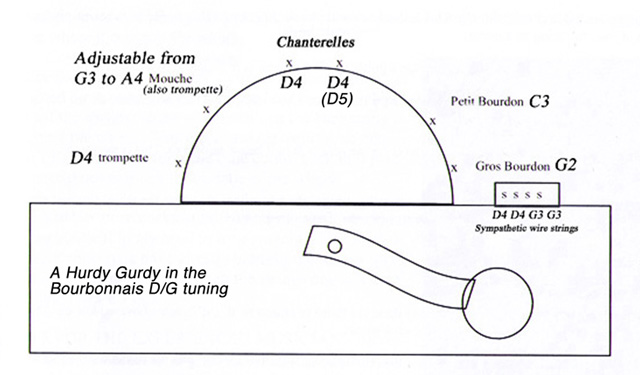
The lower row of keys on a G/C gurdy are all like the white keys on a piano. The upper row of keys are all like the black keys on a piano. This isn’t the case with the
D/G gurdy, where the keys are e, f#, g, a, b, c, d, e, f#, g, a, b, c. This is a G Scale and is handy because so much music is in G, requiring the f#, and you don’t have to
shift to the upper row of keys to play that note.
One solution is to simply read the G/C music on your D/G gurdy as if it were actually tuned to G/C, so you will be playing each song a musical fourth lower. If you are
playing in a group, everyone else has to transpose their part a fourth lower. Another solution, if you have two melody strings, is to tune one to d’ and the other to the
higher note g’. You would need at least two, preferably three drone strings to serve each tuning. In addition, the trompette string, normally d’ on a D/G gurdy, can be
tuned down to c’ to match the G/C gurdy tuning without a significant loss of string tension and sound.
I found that D/G works best for early music as well as Celtic and Irish music, Renaissance music, Playford, and much traditional French music of the Berry region in
central France. (This is called "Bourbonnais" or "Berrichon" tuning.) A lot of Medieval and Celtic music requires an A drone instead of G. Having a capo to shift the G to A
is a necessity!
The G/C tuning seems to be preferred for traditional French dance music of the Auvergne, a region in the center of France, and in Brittany. It is also the tuning used in
the Baroque era when all things pastoral became a fad and much court music was composed for the instrument. One important thing to consider is: Do other people you
will be playing with have instruments that are in specific keys? For instance, if you are playing with Melodeon and Bagpipe players you'd want a gurdy in a key that is
compatible with theirs.
Buying a Hurdy Gurdy - Serious Advice for Beginners!
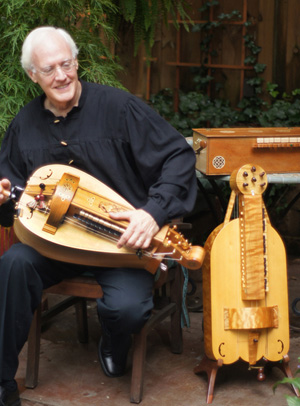
Really cheap hurdy gurdys exist because neither the builder nor the buyer understands what the instrument is capable of. I’ve been a full-time string instrument maker
for more than forty years, and although I don’t build gurdies, I have owned six of them and have repaired and rebuilt many others.
A well-made gurdy is a very sophisticated instrument, capable of a wealth of expression. It can be made to growl like an animal or sing like a bird. The drone strings
can suggest anything from the snarl of bagpipes to the wind in the trees, and can recreate the delicate balance of medieval music or the searing quality of heavy metal.
Adjustments to the drone stops allow the player to achieve the desired balance between the volume of the drones and the melody strings. Other adjustments can change the
voicing, color, and dynamics of the gurdy, because a good builder has taken his time to master his craft and produce a well-tuned machine with all the precision of any
orchestral instrument. Interestingly, acoustic analysis of the gurdy shows waveforms irregular enough to suggest three instruments rather than one. Imagine the
possibilities!
And I haven’t even started on the trompette, the little buzzing bridge of the gurdy. A well-adjusted trompette allows the player to produce a rhythmic, percussive effect
to accompany the tune. Just like a good drummer, the gurdy player can change the rhythmic structure of one or more measures of music by replacing simple 1-2 rhythms with a
wide selection of rhythmic variations. The player can put a syncopated rhythm, a waltz rhythm, a continuous or intermittent buzz, or any number of staccato or legato,
harder or softer, long or short, effects under the tune to enhance and beautify the music in unexpected ways. An accomplished player player can take a simple tune and
introduce distinctly divergent rhythmic patterns underneath it to make a familiar piece new and exciting. A carefully built and sensitive trompette will allow you to
explore all the wonders the music has to offer!
My point is, if you buy a cheap gurdy from a maker who doesn’t fully understand the instrument and hasn’t the skill to create these subtle adjustments, you will get none
of the above and will very soon become very frustrated with the limitations of the thing. Would you buy a “beginner’s piano” that was really cheap because it couldn’t be
tuned and more than half the keys were missing? You wouldn’t - because you already know what a piano is capable of sounding like. The cheap instrument you typically see on
eBay or elsewhere is a partially functional box that will prevent you from learning any of the skills mentioned above. Save your money and invest in an instrument you can
grow into rather one that will quickly abandon. It’s a glorious undertaking and it’s well worth the wait.
Difference between the Western European hurdy gurdy (la vielle à roue) and the Central and Eastern European gurdy (including the Hungarian Tekerö) There
are so many variations of the hurdy gurdy (the imaginative and creative adaptations are almost limitless) that these differences should be understood in a general sense.
Strict definitions of gurdies are vanishing as the instrument evolves. Originally, the Western European gurdy, defined by the French vielle à roue, had a larger wheel than
the Eastern gurdy. With a larger wheel, more strings were added and I have seen gurdies with 3 and 4 melody strings as well as numerous drones. The melody strings are
placed inside the keybox and the drones are outside, on either side of the keybox. In Eastern Europe, instruments with a smaller wheel, one or two melody strings and two
drones have all the strings inside the keybox. The strings are heavier to increase the volume and the buzzing bridge is a totally different system. The Eastern gurdy (photo
on the left) uses a wooden bar and platen that produces a louder buzz than the French style gurdy (photo on the right) with it's little dog, or "chien." Modern French
gurdies can have one, two, or even three buzzing bridges. I may have seen four on someone's gurdy!
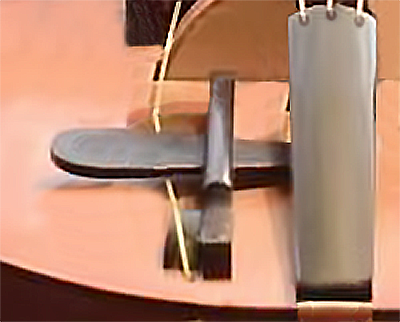 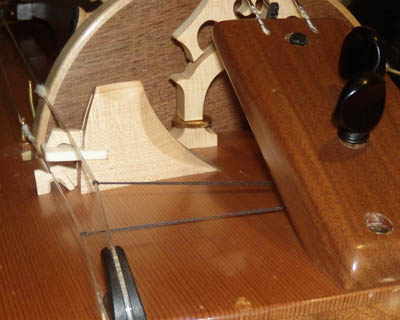
The little buzzing chiens on a French gurdy can be finely tuned to produced very clean, sharp, percussive effects. In the hands of an
experienced player, the buzzing can be made staccato or legato, loud or soft, syncopated or one long continuous buzz. The photo on the left shows how the "dogs" are carved
from solid pieces of wood (different varieties produces subtle variations in tone). The photo on the right shows some alterations that I made to my own gurdy to get the
dogs to respond quickly and cleanly (I have two buzzing bridge systems with a capo on each string, giving me four possible drone notes). Even if the maker has done his job
and you have sensitive, well-made dogs, it's always fun to carve your own and experiment a bit with different results! Every serious gurdy player really ought to be able to
carve his or her own dogs and understand how the system works. The photo on the right shows some modifications I made to one of my own instruments. Every instrument is
going to be different and require different adjustments. 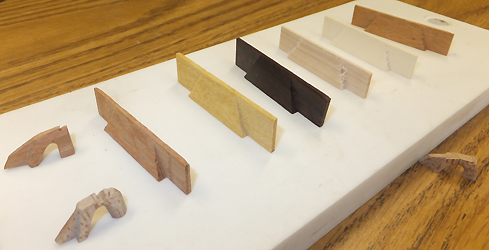 
The Coup
Coup de poignet, or more simply, coup: (noun) A stroke or sudden rapid movement of the hurdy gurdy crank that produces a distinct buzz in one of the strings. Also
referred to as trompette technique. Includes about eight separate movements to produce eight different buzzing effects. This can include flicks of the wrist as well as the
fingers. The simplest buzz can be accomplished with an arm motion, whipping the crank around with the aid of the wrist, and some beginning players use this technique on the
French style hurdy gurdy, but more sophisticated effects require precise movements of the wrist and/or the fingers. The arm technique is more commonly found with players of
the Hungarian Tekerö. A good finger technique can take a few years to learn.
In Baroque HG music, The trompette is typically quieter and more neat than in French folk music, or even absent. With French-style instruments, the sensitivity of the
buzzing bridge can be altered by turning a peg called a tirant located in the tailpiece of the instrument. It is connected by a thread to the trompette string.
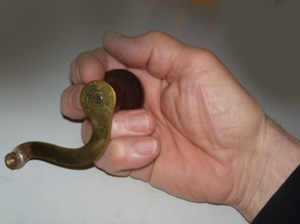 A handle that is loosely fit and wobbles will work against the
sensitive and subtle motions necessary to achieve a clean buzzing sound by absorbing some of the tiny changes in speed you are generating with your coup technique. The
wooden handle should spin freely on the crank shaft, but in no account should it wobble from side to side. This will give you the most sensitive response to your coup and
allow you to explore complex rhythms. The handle rests lightly in the hand and is free to move about. The shape of the hand changes very little and the fingers can
propel the handle a small distance in several different directions. The best videos I have seen that explain this technique were made by Scott Gayman (see the YouTube link
near the top of this page). I've studied with Scott Gayman and he has, in my opinion, the most highly developed and versatile coup technique I have ever heard. There are
simpler methods in use, including wrist and arm movements, but I have never seen them taken to the level of expertise demonstrated by Scott and other players who use the
finger technique shown in these videos. The setup of the buzzing bridge on the Hungarian Tekerö necessitates a slightly different technique, using an overhand
grip. I don't play the Tekerö and haven't analyzed that technique in enough detail to discuss it here. |
Hurdy Gurdy Makers Over the years, at workshops and other venues, I have had the opportunity to play hurdy gurdies built by many, many different makers.
Following is a list of the hurdy gurdy builders I felt were the best. My recomendations are based on owners' satisfaction with the instrument, playability of the
instrument, response of the chien, tonal qualities, tunability, and overall craftsmanship. Bear in mind that many amateur builders have attempted to construct a gurdy with
somewhat disastrous results. These instruments typically end up on eBay. The hurdy gurdy is a technical tour-de-force and difficult to replicate in a totally satisfactory
way. The gurdy itself is somewhat temperamental and typically requires a higher level of maintenance than many other instruments. If the builder hasn't the experience to
create an instrument that is low maintenance, the results can be quite frustrating for the player. I have seen some players actually give up the instrument because they had
a bad gurdy.
Warning! NEVER purchase an instrument on eBay without first consulting the friendly, experienced members of the Facebook group Hurdy Gurdy Player. 99% of the eBay "hurdy gurdies" are a disaster, suitable for wall hangings or
firewood only. Sorry to be so blunt, but I have personally known beginning players who were taken in by the lure of cheap instruments to their ultimate despair. A badly
made instrument be so frustrating that it will easily destroy your interest in the gurdy.
I attend the hurdy gurdy workshop in Indiana to teach every year. This is a list of makers that I personally know to have built very satisfactory instruments. This list
is current as of October, 2022. There are many other fine makers whose instruments I haven't played.
(This list is incomplete - I am still adding to it! New makers in Europe are constantly appearing. Please note that most of these makers have waiting lists of 2 to 4
years.)
Important note on shipping an instrument to and from the USA:
The cost to ship an instrument to the US is quite low, about $200.00 US with insurance. However,
the cost of shipping a gurdy back to Europe or China for repairs or returns is quite high. UPS and Fed Ex about $800.00. DHL about $700.00. Be absolutely certain
that you are ordering from a reputable maker and getting exactly what you need and want.
In the UK and Europe:
Another source of gurdies is the Facebook page Hurdy Gurdy Makers ListThese instrument
makers are in Europe, and only one (Michael Op) in the US. Before buying anything from this page, research reviews of the maker and read my note about shipping charges
above!
In the USA In the US, the finest maker is Michael Op at Dakota Strings. He carries on the tradition of Mel Dorries
at Hurdy Gurdy Crafters. Sadly, Mel Dorries has retired, taken down his website, and no longer accepts orders for instruments. He was one of the finest makers in the world
and the best in the United States. Michael worked with him and builds instruments of the same quality.
So you want to build a gurdy? A complete list of available plans and books can be found HERE.
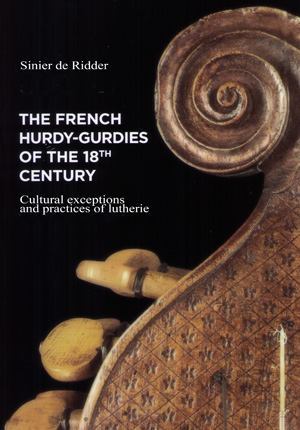 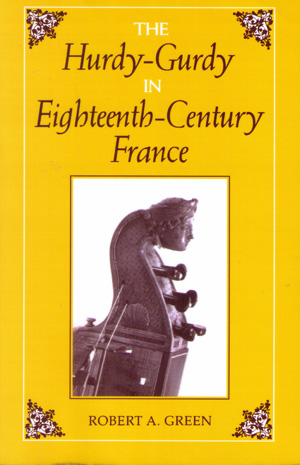
A Hurdy-Gurdy bibliography Die Drehleier • La Vielle • The Hurdy-Gurdy, Adjustment and Maintenance Destrum, Philippe; 1993 A.M.T.A.;
ISBN 2-9507682-0-2 The Hurdy Gurdy Handbook Nagy Balázc; Hungarion Heritage House Publication Series, 2006 ISBN 963-7363-10-6 The
Hurdy-Gurdy in Eighteenh-Century France Greene, Robert A.; Indiana University Press1995; ISBN 0-253-20942-0 The Hurdy Gurdy Palmer, Susann; Pub. David
& Charles Inc. 1980; ISBN 0-7153-7888-0 The French Hurdy Gurdies of the 18th CenturyFrancois de Ridder and Daniel Sinier; ISBN 978-9584470-1-4
|

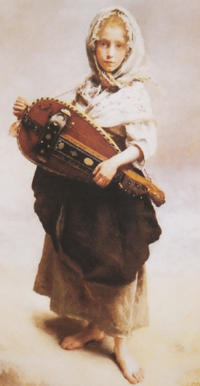
 What a hurdy gurdy is not: The barrel organ, played by an organ grinder with a monkey, is often
erroneously called a hurdy gurdy. This instrument has a wind chest with a bellows that blows into little organ pipes. It plays a fixed melody when the crank is turned and
does not have a keyboard to play different melodies. The musician is often accompanied by a monkey. There is absolutely nothing on this instrument that can be found on the
hurdy gurdy, except the turning crank. It is completely unrelated.
What a hurdy gurdy is not: The barrel organ, played by an organ grinder with a monkey, is often
erroneously called a hurdy gurdy. This instrument has a wind chest with a bellows that blows into little organ pipes. It plays a fixed melody when the crank is turned and
does not have a keyboard to play different melodies. The musician is often accompanied by a monkey. There is absolutely nothing on this instrument that can be found on the
hurdy gurdy, except the turning crank. It is completely unrelated. The first hurdy-gurdy workshop in the Midwest took place on April 20-22, 2012 in scenic Brown
County, Indiana. It was attended by both amateurs and professional players who were able to learn and play alongside other enthusiasts in a relaxed atmosphere with renowned
teachers and performers. Click
The first hurdy-gurdy workshop in the Midwest took place on April 20-22, 2012 in scenic Brown
County, Indiana. It was attended by both amateurs and professional players who were able to learn and play alongside other enthusiasts in a relaxed atmosphere with renowned
teachers and performers. Click  At right, a class in performing the "coup" was taught by Tom Lozano (September of 2013). Tom is a musician, writer, and
scholar currently living in Bloomington Indiana, who was born in Spain to Andalusian parents. He specialized in Catalan folk and medieval music in Spain. He is a solo
artist and performs in various groups across the country. The coup refers to the hand motions that articulate the trompette strings to create a rhythmic buzzing.
At right, a class in performing the "coup" was taught by Tom Lozano (September of 2013). Tom is a musician, writer, and
scholar currently living in Bloomington Indiana, who was born in Spain to Andalusian parents. He specialized in Catalan folk and medieval music in Spain. He is a solo
artist and performs in various groups across the country. The coup refers to the hand motions that articulate the trompette strings to create a rhythmic buzzing. Juan Wijngaard, who has played with the band Blowzabella, offered intermediate/advanced technique, repertory
of modern/traditional music, as well as basic Hurdy-Gurdy set-up. His repertory is mainly French and Spanish traditional music.
Juan Wijngaard, who has played with the band Blowzabella, offered intermediate/advanced technique, repertory
of modern/traditional music, as well as basic Hurdy-Gurdy set-up. His repertory is mainly French and Spanish traditional music. Mel Dorries, of
Mel Dorries, of  Robert Greene, author of The Hurdy-Gurdy in Eighteenth-Century France (1995, ISBN 0-253-20942-0)
was on hand and suggested some interesting experiments that could be done with the chien and some of the other strings (left).
Robert Greene, author of The Hurdy-Gurdy in Eighteenth-Century France (1995, ISBN 0-253-20942-0)
was on hand and suggested some interesting experiments that could be done with the chien and some of the other strings (left).







